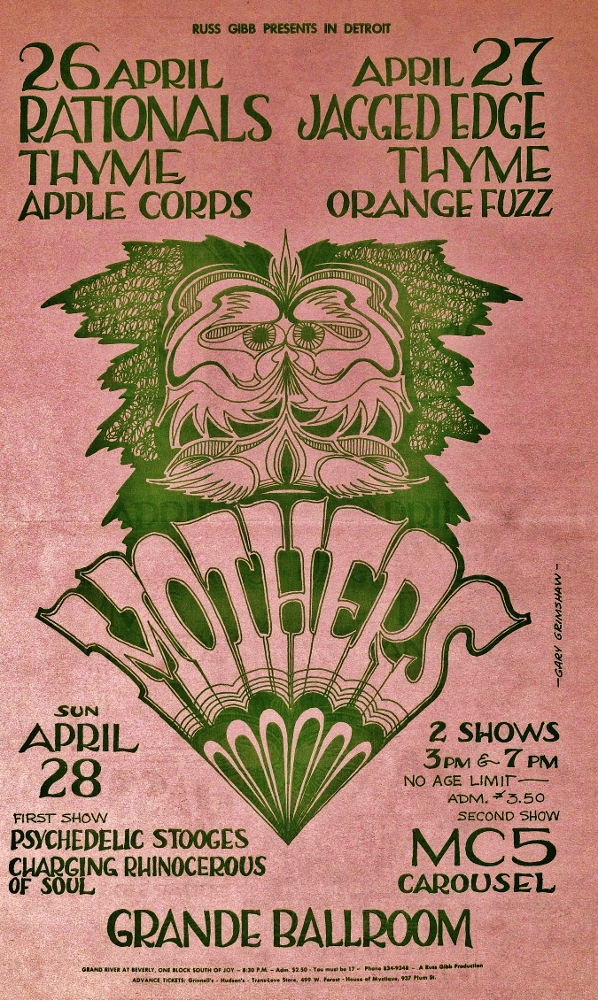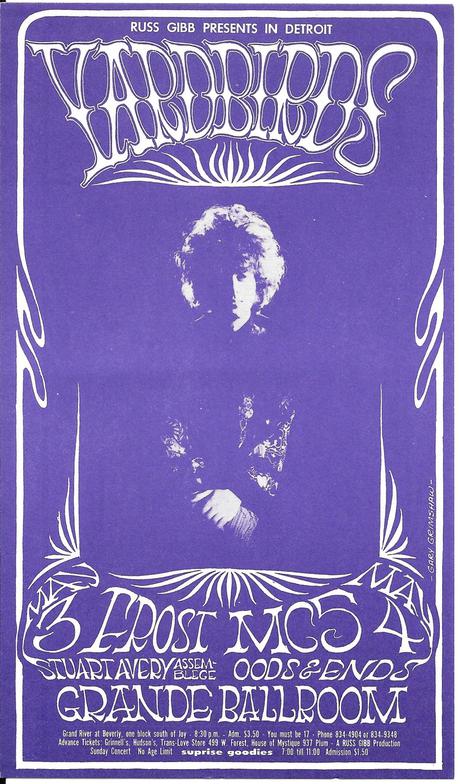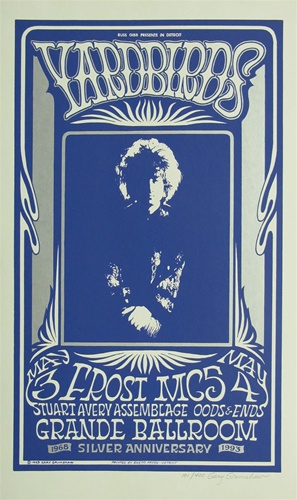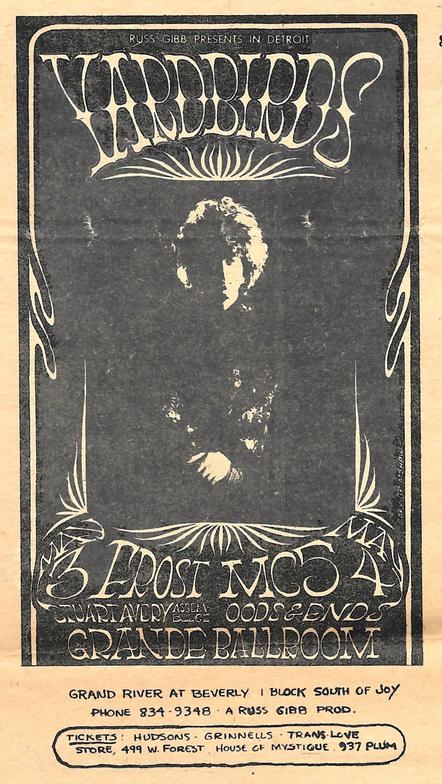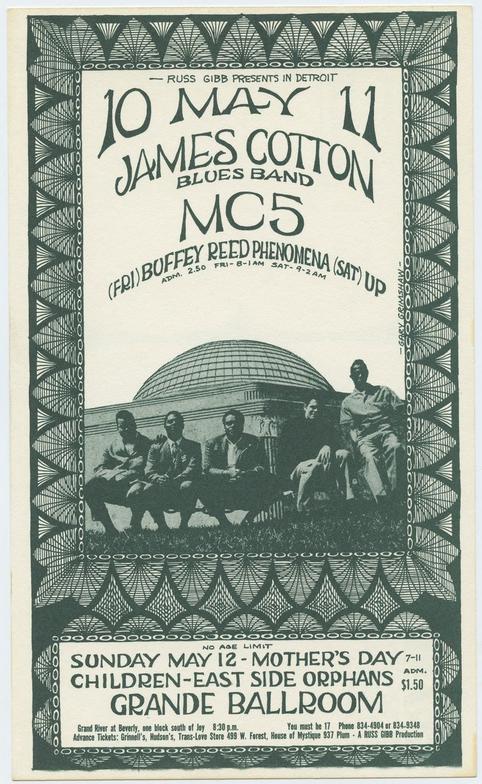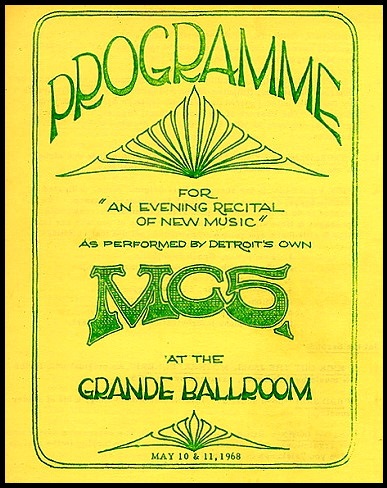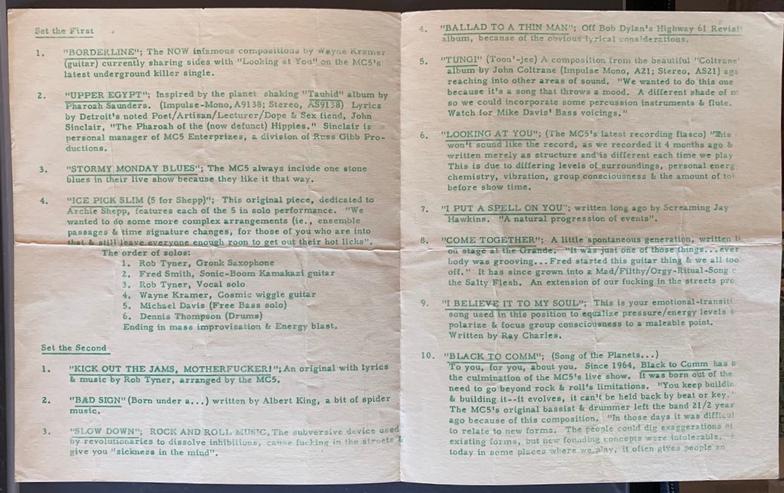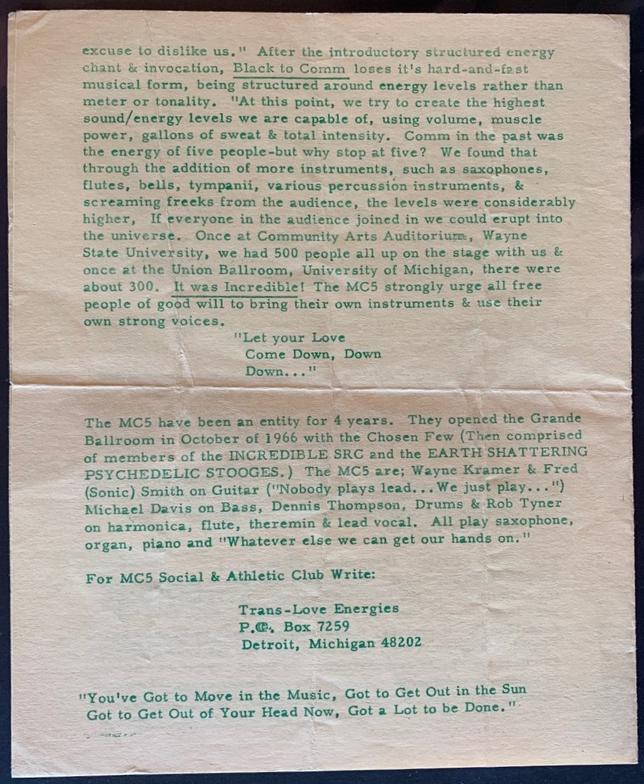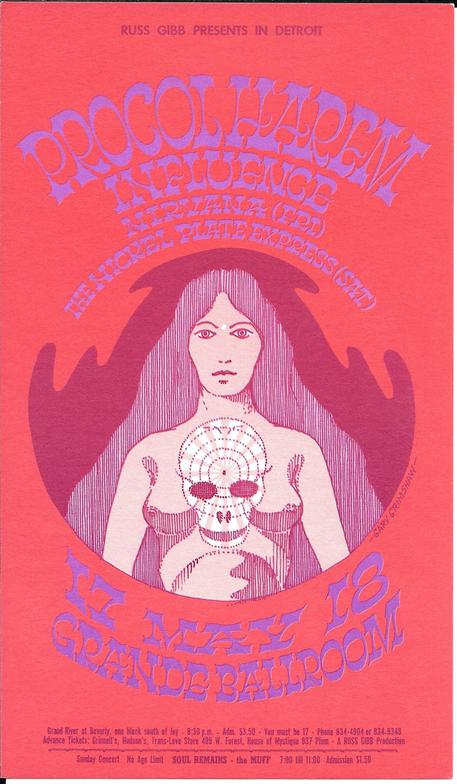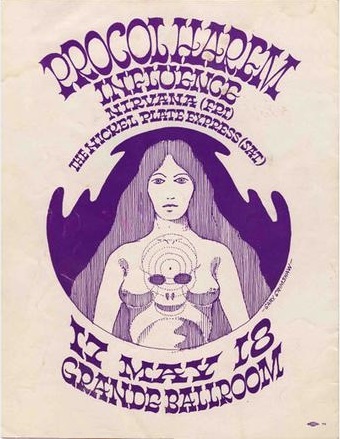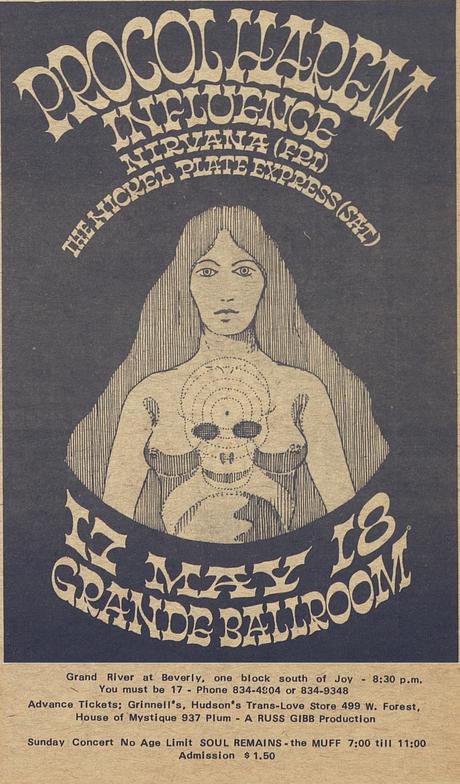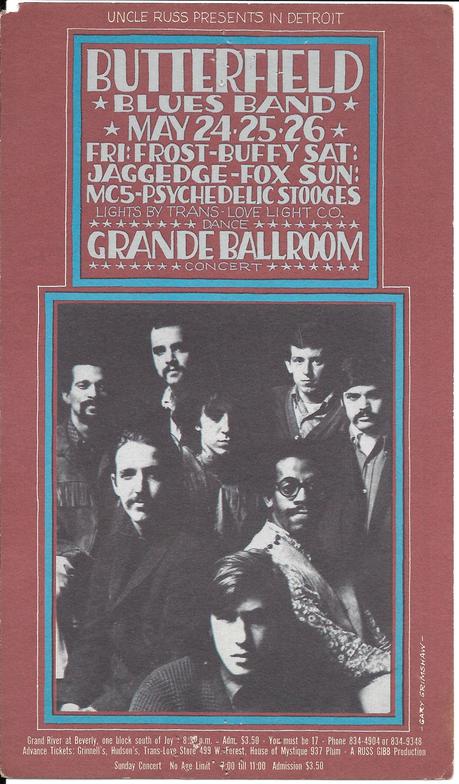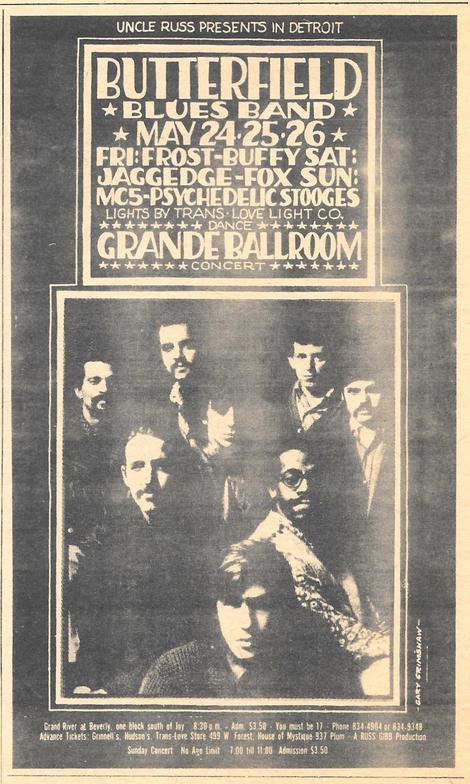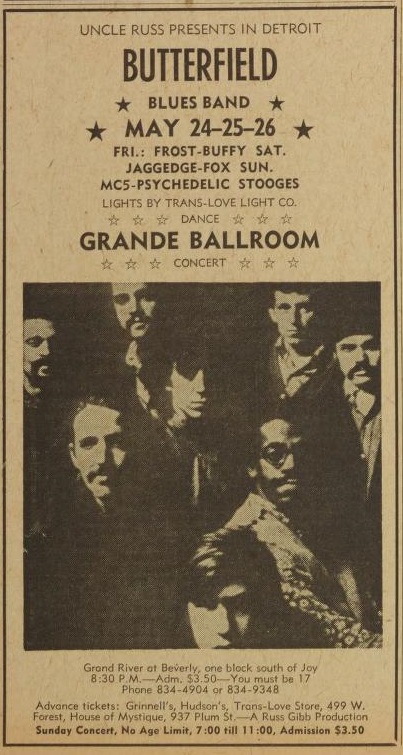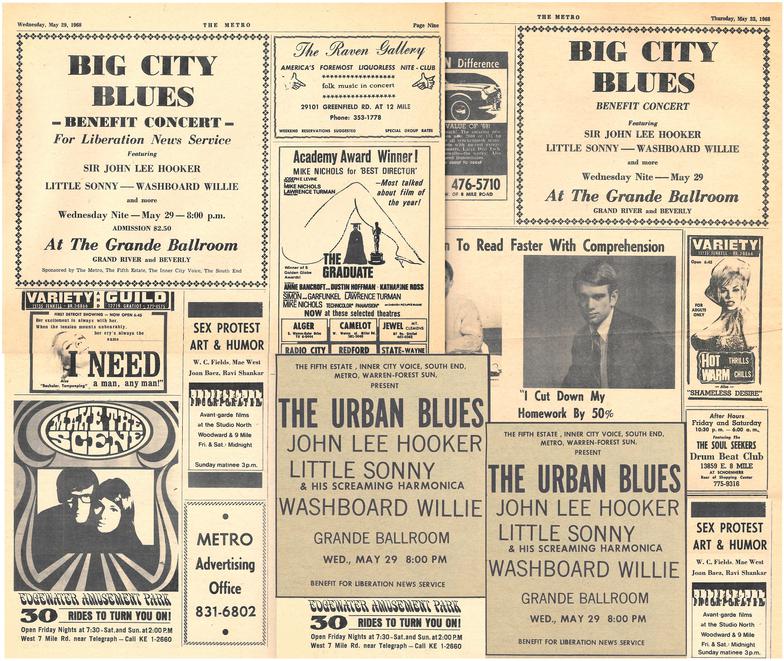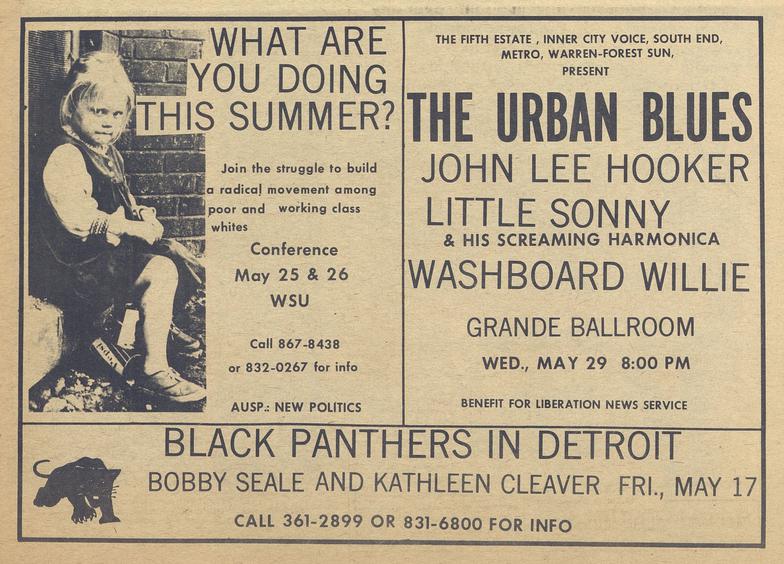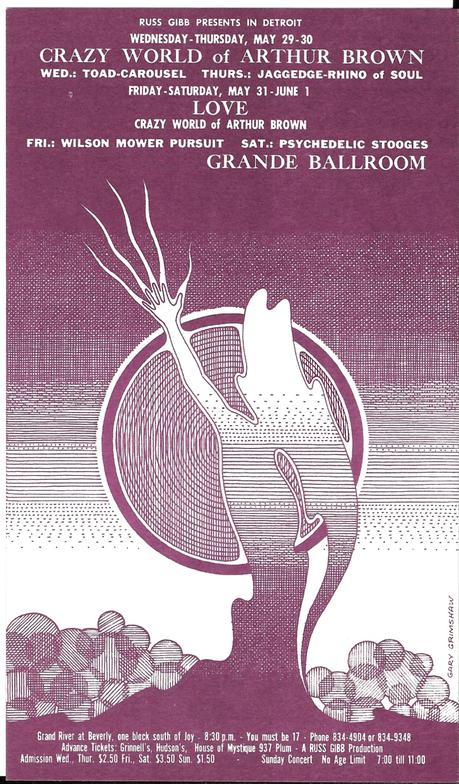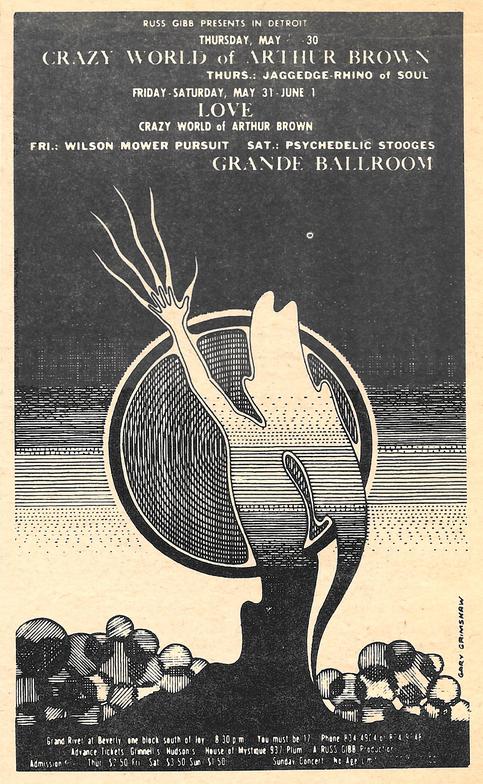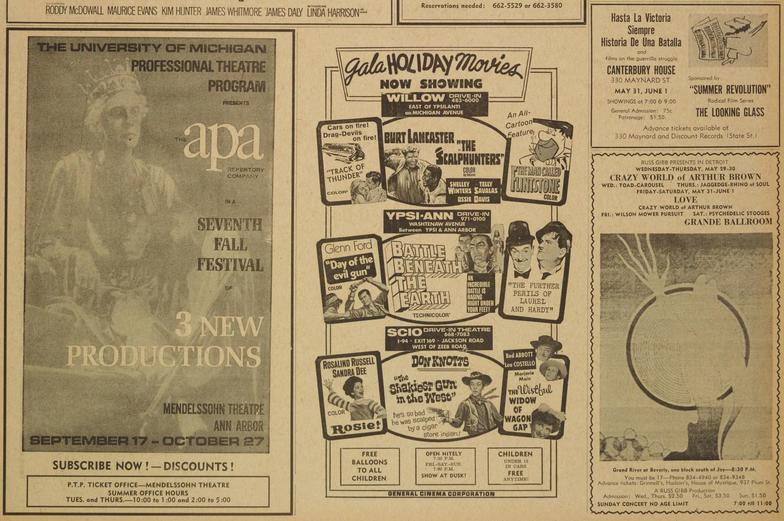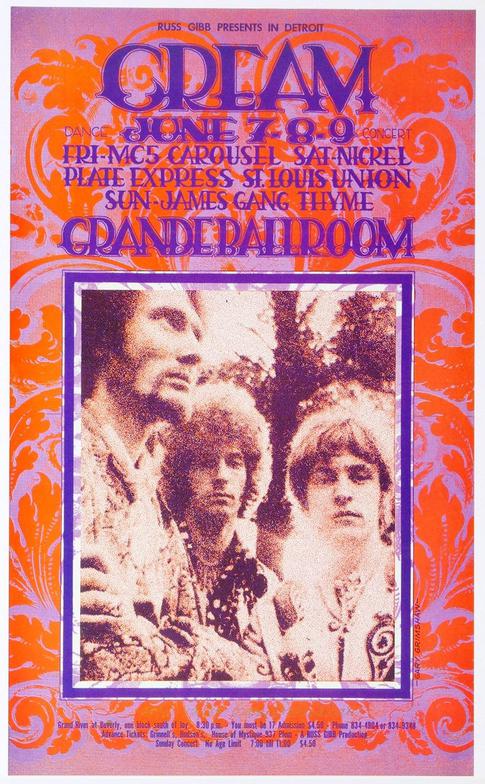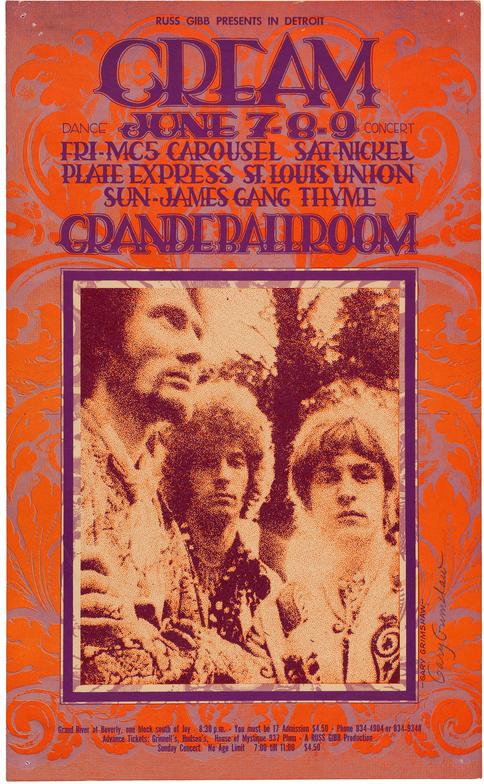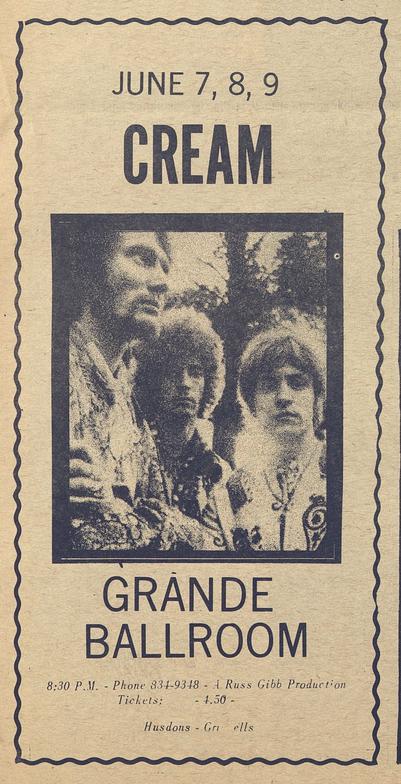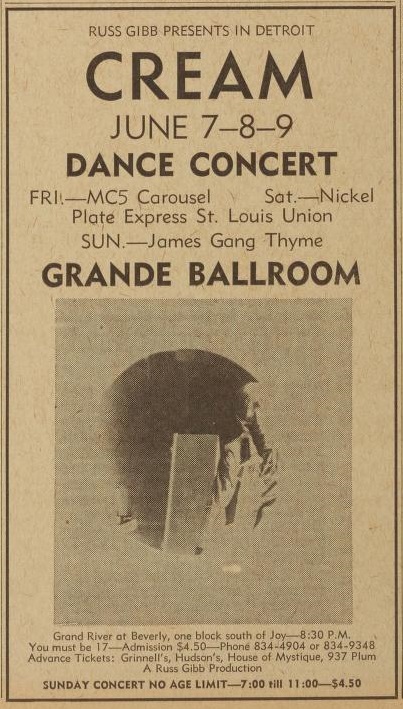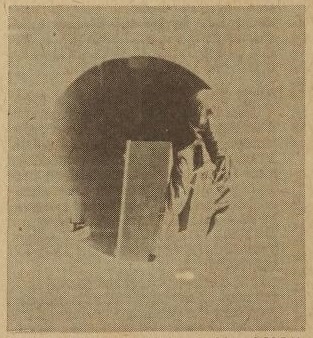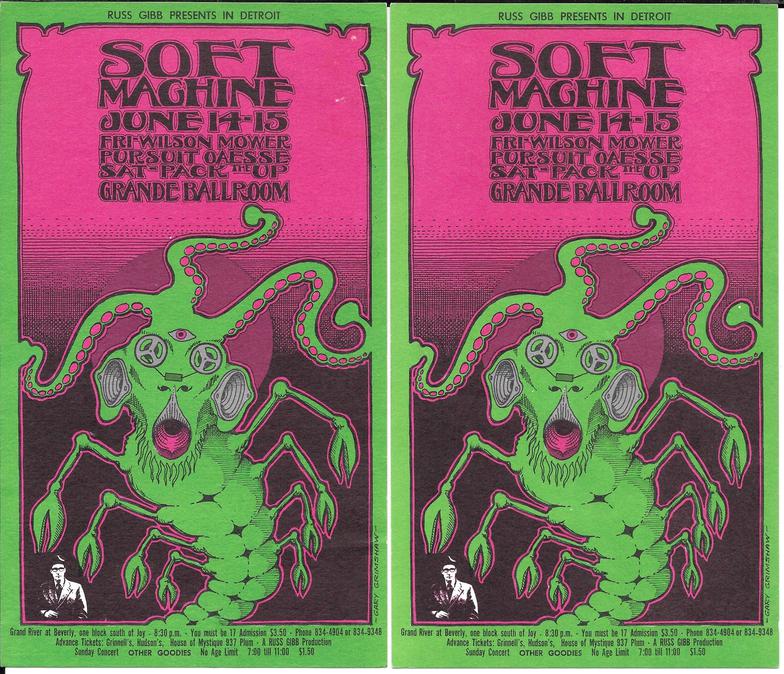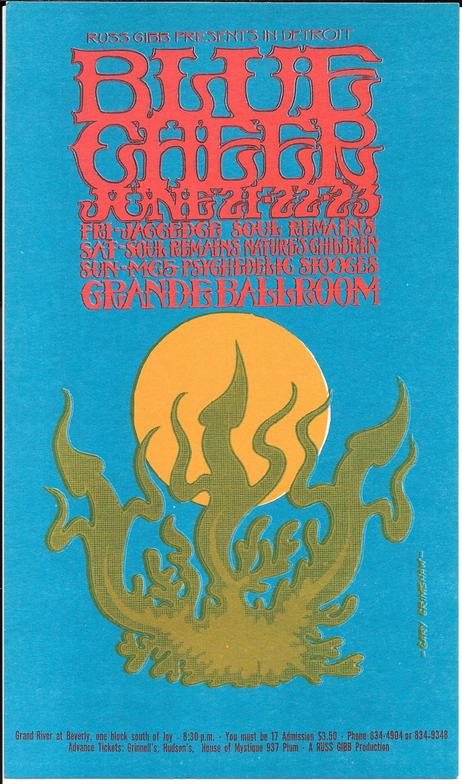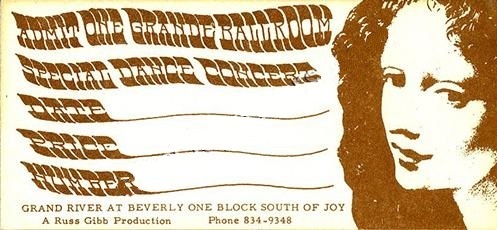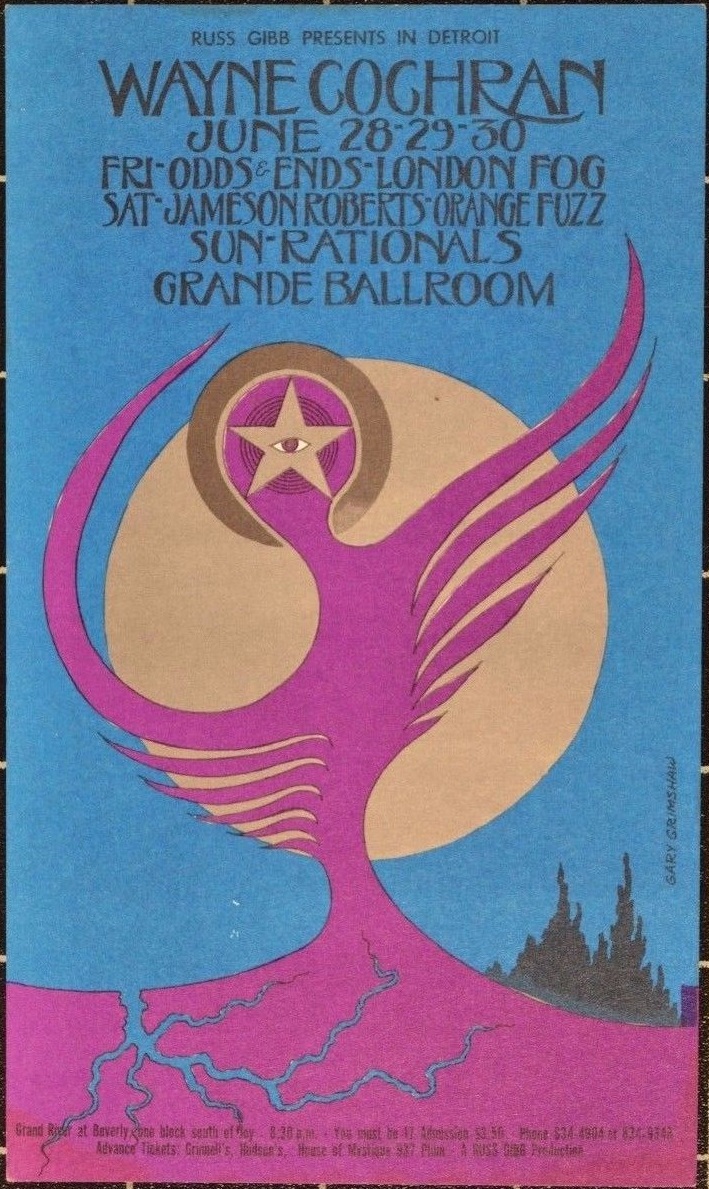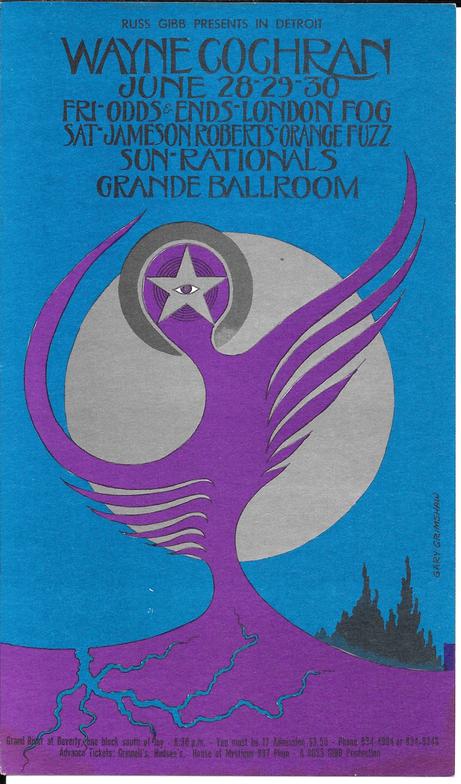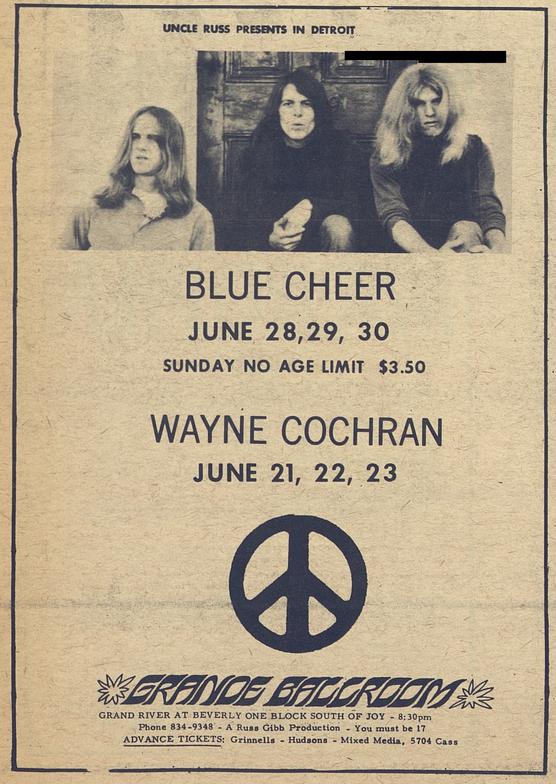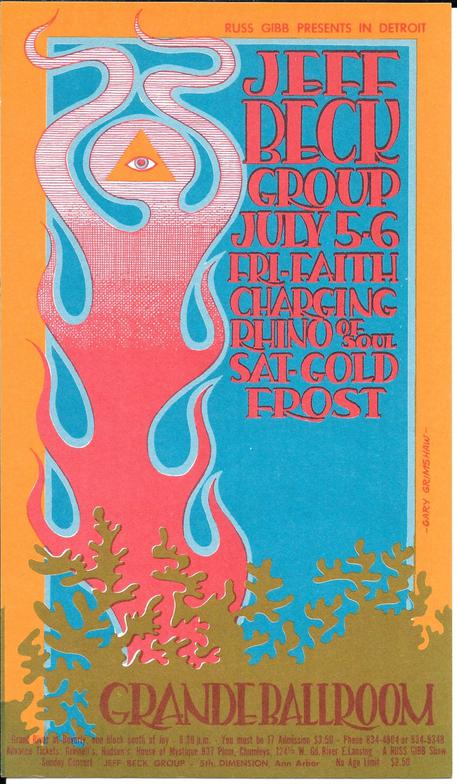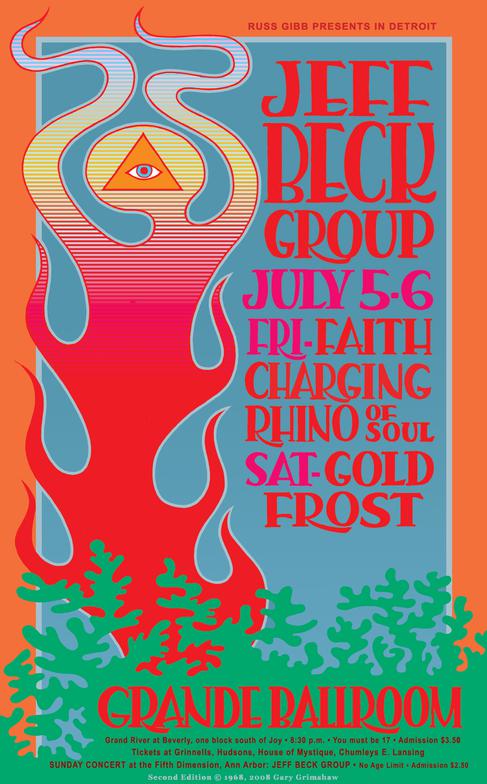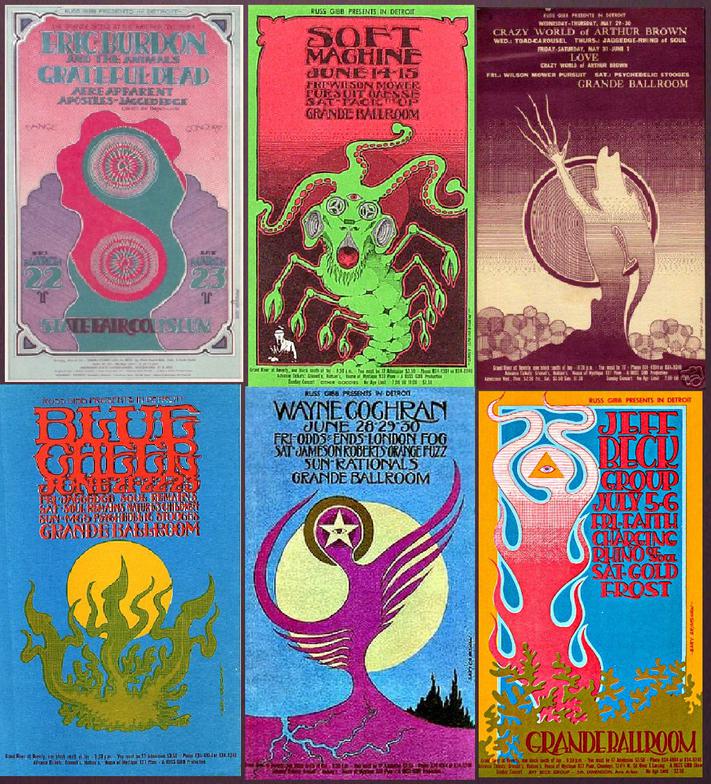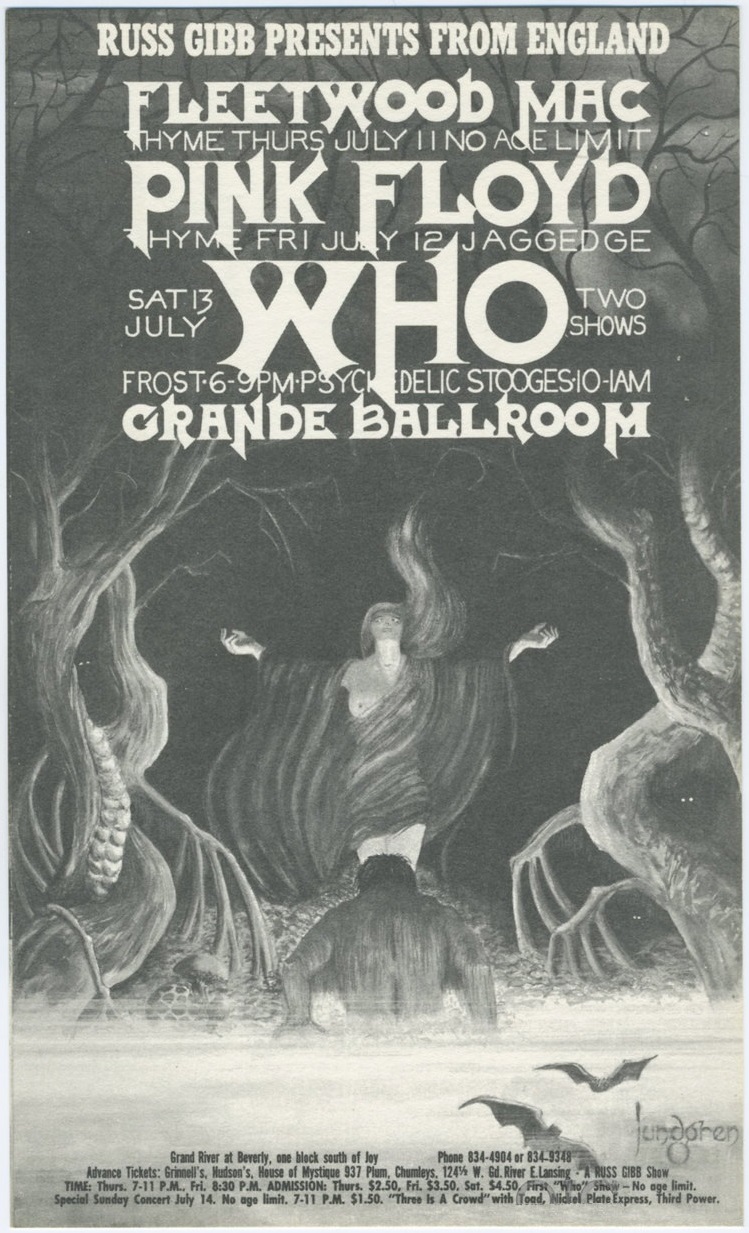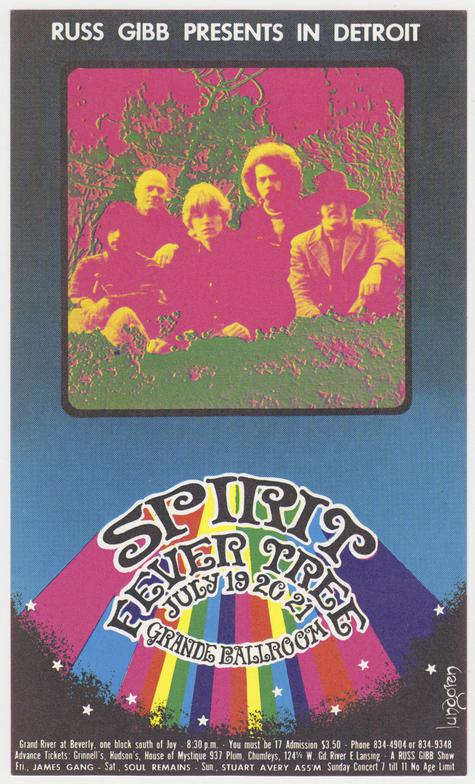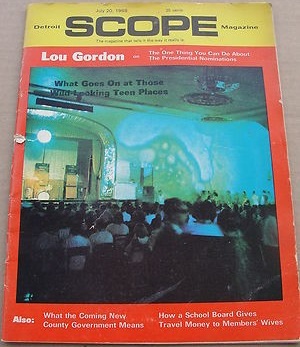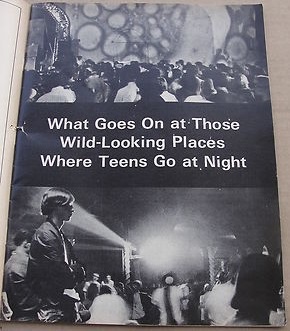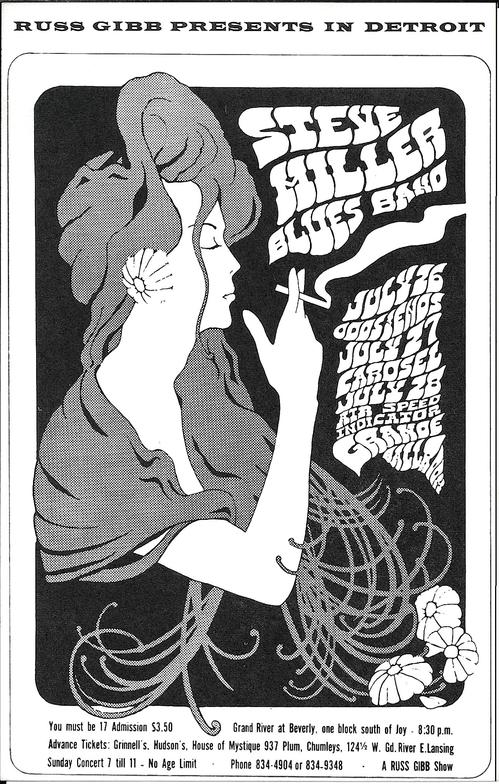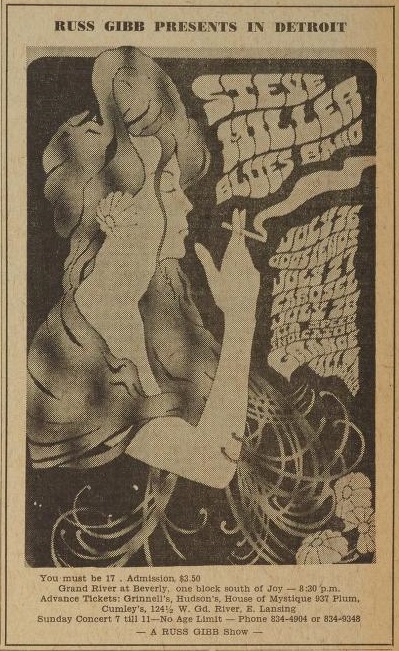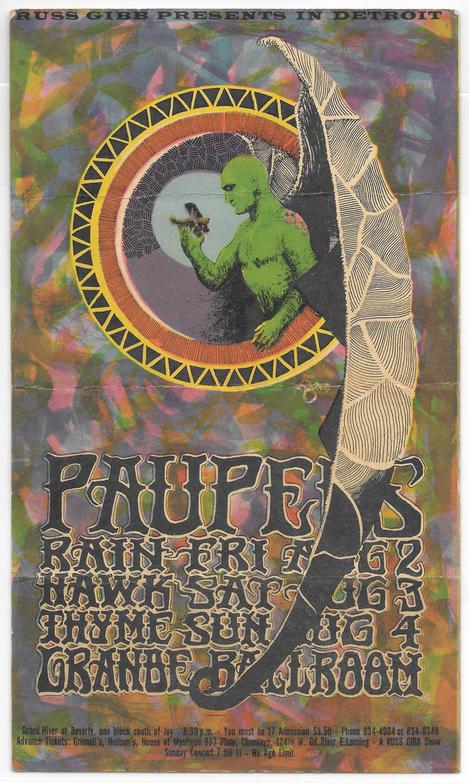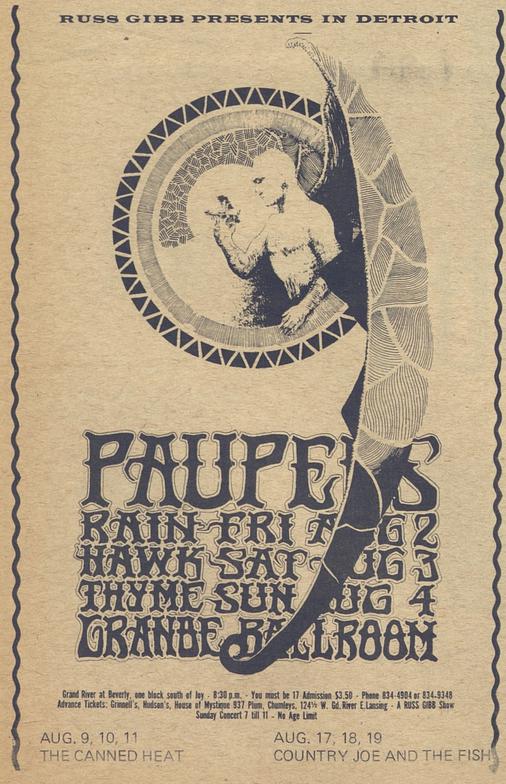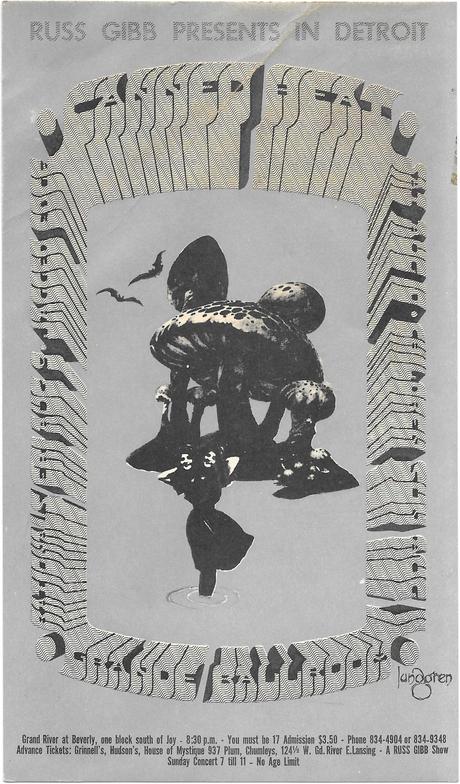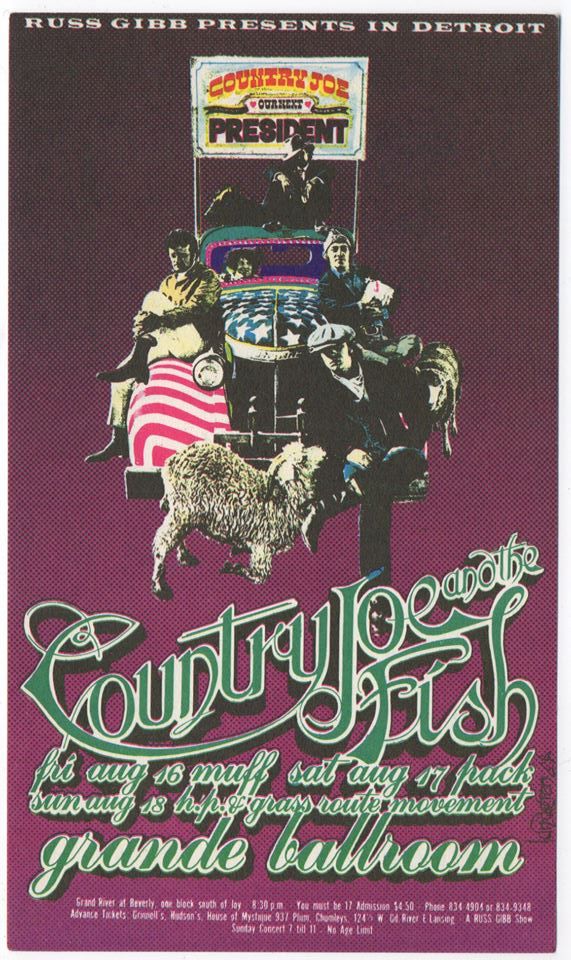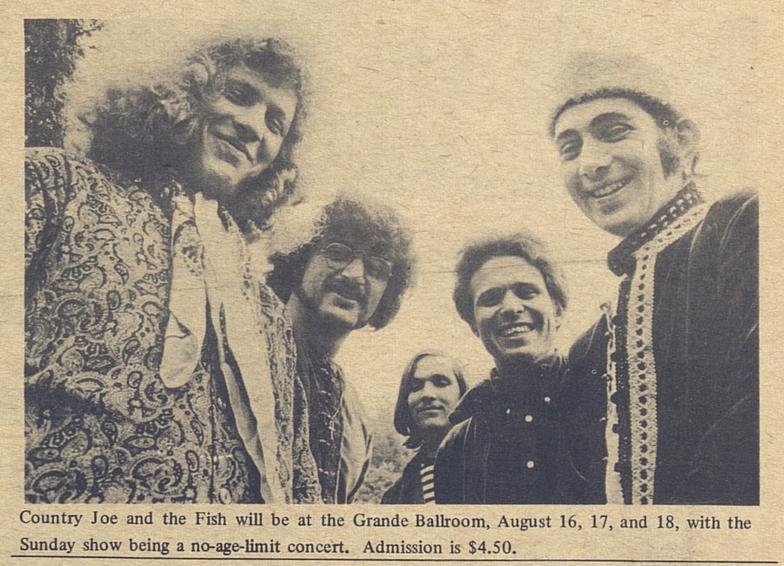Splatt Gallery
Double click here to add text.
Splatt Gallery's History of Michigan Concert Posters
The Grande Ballroom Posters - Page Six
Here is the version of Gary Grimshaw’s Mothers poster as it appeared as the back page of Issue #7 of the SUN newspaper, April 19 – May 2, 1968. This is the best picture of it that we’ve found, you can see a background layer under the green that includes the word “April” twice.
********************************************************
The 83rd weekend at The Grande Ballroom, May 3-4, 1968 featured Gary Grimshaw’s 48th poster for the venue. The Yardbirds headlined both nights, with support by Stuart Avery Assemblage and Frost, and MC5 and Odds & Ends.
This image was originally produced only as a 4” x 7” postcard. There was no original poster for this event.
In 1993, Gary Grimshaw produced a hand signed and numbered edition of 400 posters measuring approximately 13″ x 23″. This 1993 re-issue has a silver background (see below)
This was the final Yardbirds tour before Jimmy Page left to start Led Zeppelin.
Although the Stuart Avery Assemblage are listed in the concert database as having performed at the Grande Ballroom on October 28, 1967, opening for the James Gang, their name does not appear on the poster for that show. This is the first Grande poster with their name, and it may be the transition point for the band’s drummers, as John Orlich recalls that James Render was present.
Jimmy Page took a liking to the opening band, The Stuart Avery Assemblage and even gifted their new drummer, John Orlich, still a tenth-grade high school student at the time, with a pair of his blue suede shoes. Orlich had just replaced the band’s original drummer, James Render, who quit the group to pursue an art career. We will be seeing a lot of James Render’s posters coming up.
Stuart Avery was a sixteen-year old roadie for Glenn Frey’s group The Mushrooms who got tired of lugging equipment and figured he could do what he saw the bands do onstage. He recruited a group of friends, including guitar player Paul Kingery, and formed the mouthful The Stuart Avery Assemblage, later shortened to The Assemblage.
The band was at first managed by Peg Tillika from The Cavern in Northville, who also served as their costume designer, then went through a succession of managers that included Jeep Holland, Punch Andrews, and Dave Leone.
We’ll be seeing The SAA on a lot of the posters coming up as they performed everywhere and frequently. John Orlich has described his band as “a second-tier Detroit act”, with the others being The Wilson Mower Pursuit, The Jagged Edge, Third Power, The Up, Frut, and The Popcorn Blizzard. “The first-tier was, of course, SRC, Bob Seger, The Amboy Dukes, The Frost, The MC5, and The Stooges.”
Later, as The Assemblage, the band recorded an album in 1971 on the Westbound label. Apparently, the sessions were excruciating and the band detested the results, from the album title and cover art (it was going to be called “Guts” spelled out in a drawing of intestines), to the sound which was over-produced and mutated beyond recognition from the hard rock they played in their live appearances.
In fact, it was so bad that it broke up the band. Stuart Avery worked briefly with Edgar Winter’s White Trash, then became an executive with the global tea company, The Republic of Tea, Paul Kingery formed additional bands, Stretch Thomas and Air Condo, played guitar on later Seger recordings, and became the bass player for the re-united Three Dog Night in the 80’s. Keyboardist Robyn Robins, who came to The Assemblage from the band Virgin Dawn, became part of the classic Silver Bullet Band line-up.
John Orlich made a career of working in stained glass, eventually incorporating the craft into making custom glass-shelled drum kits that were used by Alan White of Yes, Tris Imboden of Chicago, and an artist formerly known as Prince.
Here is the single from their album, a unique cover version of “Satisfaction” that cunningly never cites the song’s famous riff.
The Stuart Avery Assemblage – Satisfaction (1971)
https://www.youtube.com/watch?v=XDH9sO_d-Eg
The 1993 “Silver Anniversary” re-issue of Gary Grimshaw’s poster for the Yardbirds at the Grande Ballroom, May 3-4, 1968.
A newsprint version of Gary Grimshaw’s poster for the Yardbirds at the Grande Ballroom, May 3-4, 1968.
The 84th weekend at The Grande Ballroom, May 10-12, 1968 featured Gary Grimshaw’s 49th poster for the venue. The James Cotton Blues Band headlined two nights, with MC5 opening both nights, with the Buffy Reed Phenomena and the UP one night each. The poster also includes a Sunday show, on Mother’s Day, May 12th, with appropriately named groups Children and Eastside Orphans.
This image was produced only as a 4” x 7” postcard. No poster is known to exist for this event.
When John and Leni Sinclair returned home after a night at the Grande, they discovered their house, which also served as the offices for Trans-Love Energies, had been fire-bombed. No one was hurt since they’d all been at the show, but this was the second time this had happened, and the Detroit police, seemingly uninterested in investigating these crimes, were instead increasingly becoming a source of intimidation and harassment.
So Sinclair decided to move the entire operation, with the commune of 28 people, including the MC5 and The Up, family and friends, away from the city of Detroit and out to Ann Arbor, where he found two large, adjacent houses on Hill Street.
Five years after joining up with the group at the Red Door Gallery and starting the Detroit Artists Workshop, Sinclair was leaving the city that had informed him and emboldened him, that had inspired his writing, opened his mind to rock and roll, and kept him well supplied with weed and acid.
There was also a “Programme” printed up for the May 10-11, 1968 weekend at the Grande Ballroom with this cover art by Gary Grimshaw.
The inside pages of the “Programme” for the May 10-11, 1968 weekend at the Grande Ballroom, with details on the MC5 sets.
The back cover of the “Programme” for the May 10-11, 1968 weekend at the Grande Ballroom, with details on the MC5 sets.
The 85th weekend at The Grande Ballroom, May 17-19, 1968 featured Gary Grimshaw’s 50th poster for the venue. Procol Harum headlined two nights with support by a band named Influence both nights, and with Nirvana and Nickel Plate Express, one night each. There was also a Sunday night show with the Soul Remains and Muff.
This image was produced only as a postcard.
One of the most frequently misspelled band names, Procol Harum, is in fact misspelled on this poster. Detroit was a favorite destination for the English band, appearing over 30 times in the next few years, with a strong fan base that included the city’s musicians. They would sometimes stay at the SRC house in Ann Arbor and reportedly there were jam sessions that were recorded in SRC’s home studio.
Procol Harum – Conquistador (1967)
https://www.youtube.com/watch?v=Kpzho2w-NHc
Gary Grimshaw’s poster for Procol Harum at the Grande Ballroom, May 17-18, 1968, as it appeared on the back cover for the concert program for The Doors at Cobo Arena on May 11th.
A newsprint version of Gary Grimshaw’s poster for Procol Harum at the Grande Ballroom, May 17-18, 1968.
The 86th weekend at the Grande Ballroom, May 24-26, 1968 featured Gary Grimshaw’s 51st poster for the venue. The Butterfield Blues Band headlined three shows, with support by Frost and Buffy Reed Phenomena, Jagged Edge and Fox, and MC5 and Psychedelic Stooges.
This image was produced only in postcard form. No poster is known to exist for this event.
There are two types of original postcards. Both have a “Grande Ballroom” imprint on the back, while one has a “Place Stamp Here” imprint on the back and the other has a “Bulk Mail Permit #642” imprint on the back. .
The Butterfield Blues Band from Chicago was a breeding ground for a long list of musicians, including Paul Butterfield, Mike Bloomfield, Elvin Bishop, Sam Lay, David Sanborn, and many others.
This video of the band at the Monterey Pop Festival in June, 1967, is notable for its exceptional quality and the vast amount of stoned faces.
https://www.youtube.com/watch?v=e3LEhfbKCSc
A newsprint version of Gary Grimshaw’s poster of the Grande Ballroom, May 24-26, 1968.
A newspaper ad for the Butterfield Blues Band at the Grande Ballroom, May 24-26, 1968.
At first, we thought these ads for “The Urban Blues” or “Big City Blues” show at the Grande Ballroom were in conflict with the Arthur Brown show at the Grande that night, May 29, 1968, but a show preview explained that John Lee Hooker, Little Sonny, Washboard Willie, “and more” would be, as a group, performing a half-hour set as a benefit for the Liberation News Service before the Arthur Brown show and supporting acts.
This would be Hooker’s third, and final, performance at the Grande Ballroom.
Another ad for John Lee Hooker, Little Sonny, and Washboard Willie at the Grande Ballroom on May 29, 1968.
The 87th weekend at the Grande Ballroom, May 29, 1968, through June 1st, featured Gary Grimshaw’s 52nd poster for the venue. The Crazy World of Arthur Brown performed all four shows, headlining the first two and second-billed to the band Love (in their Detroit debut) for the second two. Local support groups were Carousel and Toad on the first night, Charging Rhinoceros of Soul and Jagged Edge on the second night, Wilson Mower Pursuit on the third night, and Psychedelic Stooges on the fourth night.
Grimshaw began a stylistic experiment with languid, willowy shapes that would continue over the next few posters.
This image was produced only as a postcard. No poster is known to exist for this event.
Love – My Little Red Book (1966)
https://www.youtube.com/watch?v=ftO9ClIhFAo
A newsprint version of Gary Grimshaw’s poster for the Grande Ballroom, May 29, 1968.
The newsprint version of Gary Grimshaw’s poster for the Crazy World of Arthur Brown at the Grande Ballroom in its natural habitat, in the entertainment ad section of the Michigan Daily newspaper.
The 88th weekend at The Grande Ballroom, June 7-9, 1968 featured Gary Grimshaw’s 53rd poster for the venue. It was the return of Cream with the make-up shows for the earlier cancellations in April. Grimshaw re-used the band image from the earlier poster with the addition of a new paisley border.
Cream headlined all three nights, with support by Carousel, MC5, Nickel Plate Express, St. Louis Union, the James Gang, and Thyme.
The original poster measures approximately 13″ x 21″ and has a light gray background to the leaf pattern.
The original postcard measures approximately 4″ x 7″ and has a light brown background to the leaf pattern.
It was the fourth time at the Grande Ballroom for the Cleveland band, The James Gang, finding themselves very popular in Detroit. “The Gang” were appropriately named as no less than 23 members had passed through its ranks by this time. Guitarist Joe Walsh had joined the band at the beginning of 1968 making it a five-piece ensemble at the time, but with the departure of their keyboard player they were down to four members by the time of this show.
At the last minute, as they were about to go onstage at the Grande Ballroom, their second guitar player informed them he would not make the show. Needing the money, Walsh had the band go on stage as a power trio and they were so pleased with the results, they decided to remain that way.
James Gang – The Bomber (1970)
https://www.youtube.com/watch?v=u1yiCyCvW4g
Newspaper ad for Cream at the Grande Ballroom, June 7-9, 1968.
Newspaper ad for the Cream shows at the Grande Ballroom, June 7-9, 1968, with a very strange image, have no idea what it is?
The 89th weekend at The Grande Ballroom, June 14-15, 1968, featured Gary Grimshaw’s 54th poster for the venue. The Soft Machine headlined both nights with support by Oaesse, Wilson Mower Pursuit, the Pack and UP.
This image was produced only as a 4” x 7” postcard. No poster is known to exist for this event.
This has a similar circle background to the Love poster two weeks ago and is the third one in this style that was started with the State Fairgrounds poster in March.
The 90th weekend at The Grande Ballroom, June 21-23, 1968 featured Gary Grimshaw’s 55th poster for the venue and his fourth in his new motif of flowing shapes over a background circle. Blue Cheer headlined three shows, with support by Jagged Edge, Soul Remains (two nights), Nature’s Children, MC5 and Psychedelic Stooges. These shows were Blue Cheer's Michigan debut.
This image was produced only in postcard form. No poster is known to exist for this event.
The original postcard measures approximately 4″ x 7″.
Blue Cheer made music that sounded like it could have come from the Motor City, much more akin to the MC5 and the Stooges than to the Grateful Dead or Jefferson Airplane. In fact, Dickie Peterson was another Midwest transplant, moving to San Francisco from the North Dakota border with Minnesota. As much as anybody, Blue Cheer invented heavy metal and were the originals in LOUD music.
Yes, they were so loud that their second album was recorded on a pier in New York Harbor since the studio couldn’t contain them, yes, they were named after a batch of LSD, yes, they were managed by an ex-Hells’s Angel named Gut, and yes, their first album had the super cool name, Vincebus Eruptum.
Drummer Paul Whaley, whose performance in this clip must certainly have been an inspiration for Dale Crover of (The) Melvins, when pressed by the plastic Dick Clark to define Blue Cheer’s sound, simply says “Heavy”.
Also to their credit, they were hated by rival bands and despised by a newly emerging breed of assholes called “rock critics”. The plastic Dick Clark, after his stilted interview and half-praise on air, told the band after busting them backstage smoking hashish, “You’re the kind of band that gives rock and roll a bad name”. The band replied, “Thanks Dick”.
Blue Cheer – Summertime Blues (1968)
https://www.youtube.com/watch?v=KKT0Kz5VGhw
Emboldened by having avoided arrests and getting the cops and the club owner to back down, by inciting the crowd at The Hideout, The MC5 continued to push the limits at their original home, the Grande Ballroom. On the night of the Cream show, Russ Gibb caught wind of the band’s plan to burn an American flag on stage. He told them, in no uncertain terms, that if they did that he would call the police, so alternatively the band ripped the flag to shreds without incineration and hoisted a marijuana leaf banner while Jerry Younkins paraded around the stage completely nude. This was still enough to enrage the ballroom owner Gabe Glantz who fired the ballroom manager Larry Feldmann and the situation created a frosty gulf between Gibb and the MC5.
Their next appearance at the Grand Ballroom was the Blue Cheer show. Glantz showed up and warned the band against any similar shenanigans and when the band refused to commit to any such promises, he forbid the band from going on stage. After an hour of back and forth arguments while the crowd got increasingly restless, the manager for Blue Cheer said that if the MC5 were not permitted to play then Blue Cheer would also not go on, causing Glantz to relent but their set was cut short leading to more acrimony between the band and Russ Gibb.
John Sinclair pointed out the band was only making $125 a night at The Grande, the six-person light show was making $25 and Gary Grimshaw was paid $25 per poster design.
The 91st weekend at The Grande Ballroom, June 28-30, 1968 featured Gary Grimshaw’s 56th poster for the venue and his fifth in his series of flowing shapes over a background circle. Wayne Cochran headlined three nights with support by London Fog, Odds & Ends, Orange Fuzz, the Jameson Roberts Blues Band, and the Rationals.
This image was produced only in postcard form. No poster is known to exist for this event.
The postcard measures approximately 4″ x 7″.
Wayne Cochran had the same moves and the same pompadour of his friend James Brown, except Wayne’s was white, white, white. When his sixteen-piece band, the C.C. Riders, (featuring a teen-age Jaco Pastorius on bass) and his female backing vocalists, the Sheer Delights, took the stage at the Grande Ballroom, the crowd must have thought that a wedding band had misplaced its directions to a lost reception, but when they kicked into gear they were won over just as Detroit audiences had been since 1961.
Here are two clips of Cochran badly lip-synching two songs on Robin Seymour’s Swingin’ Time TV show in 1966 and a later clip of the complete band for the full effect.
Wayne Cochran – Harlem Shuffle (1966)
https://www.youtube.com/watch?v=xULvj8kgYGg
Wayne Cochran – Going Back to Miami (1966)
https://www.youtube.com/watch?v=5bvXBsJTtJM
Wayne Cochran – It’s Alright (1966)
https://www.youtube.com/watch?v=w5_GstlPL64
Newspaper ad for June 1968 shows at the Grande Ballroom. They have the dates for Blue Cheer and for Wayne Cochran switched by mistake.
The 92nd weekend at The Grande Ballroom, July 5-6, 1968 featured Gary Grimshaw’s 57th poster for the venue and his sixth in his series of flowing shapes over a background circle. The Jeff Beck Group headlined both nights, with support by Charging Rhinoceros of Soul, Faith, Frost, and Gold.
This image was originally produced only in postcard form which measures approximately 4″ x 7″. A “Second Edition” poster, measuring approximately 11” x 17” was issued in 2008 (also shown above).
After leaving The Yardbirds, Jeff Beck formed The Jeff Beck Group, recruiting the up-and-coming vocalist Rod Stewart. The new group struggled through their first year in 1967, going through a succession of drummers and failing to achieve a hit single, which then was a necessary step to advancing a career in the UK. However, road manager Peter Grant had just returned from the US, where concert halls and album-oriented FM radio were beginning to replace the teen clubs and the hit-single formula, and he convinced the band, which was the verge of breaking up, to try a short American tour.
The Jeff Beck Group opened for The Grateful Dead at the Fillmore East in New York City in June 1968, and the line-up of Beck, Stewart, Ron Wood on bass, and Mickey Waller on drums, blew the crowd and the New York media away. The reaction was equally positive across the entire tour, ending at the Fillmore West in San Francisco, and an invigorated band returned to the UK to record two classic albums.
Jeff Beck Group – Shapes of Things (1968)
https://www.youtube.com/watch?v=dFyc_WXWNtw
If you’ve been scratching your heads, wondering what we’ve been going on about over this style of background circles and flowing shapes that Gary Grimshaw was using in his posters from March through July, 1968, seeing the six of them together may help explain.
The Jeff Beck show would be the last of these and would also be the last poster that Grimshaw would make for the Grande Ballroom for nearly a year. In June, 1968, Traverse City police arrived in Ann Arbor with a warrant to arrest Grimshaw and fellow Trans-Love member Pun Plamondon on possession of marijuana charges stemming from a bust three months earlier. Plamondon was captured and incarcerated while Grimshaw escaped and fled the state.
Maybe we’ll call this Grimshaw’s Pre-Lam Phase.
The 93rd weekend at The Grande Ballroom, July 11-13, 1968 featured Carl Lundgren’s 10th poster for the venue, his first one in five months, but from here he would be The Grande’s main poster artist while Gary Grimshaw was in exile.
This image was originally produced only in postcard form. The postcard measures approximately 4″ x 7″. Lundgren later re-printed this one and a few others as large posters.
It was a big weekend for bands from England, featuring the first Detroit appearances of both Fleetwood Mac and Pink Floyd, and bringing The Who back for their fifth area appearance. Just two months earlier, Pink Floyd had reluctantly made the heartbreaking announcement that co-founder Syd Barrett was no longer in the band, following a year of his increasingly erratic acid-casualty behavior. Barrett disappeared from public view for a while.
The Thyme opened for Fleetwood Mac, and also opened for Pink Floyd, along with the Jagged Edge. The Who performed two shows on July 13th, with Frost opening the first one and the Psychedelic Stooges opening for the second show.
There was also a fifth show listed at the bottom of the poster, a Sunday night show on July 14th called “Three Is A Crowd”, with Toad, Nickel Plate Express, and Third Power, in their first Grande Ballroom appearance.
Pink Floyd – See Emily Play (1967)
https://www.youtube.com/watch?v=5R8EpAv4miA
The 94th weekend at The Grande Ballroom, July 19-21, 1968 featured Carl Lundgren’s 11th poster for the venue. Spirit headlined three nights, with support by Fever Tree all three nights. The James Gang also appeared on the first night, Soul Remains opened the second night, and Stuart Avery Assemblage opened the third night.
This image was produced only as a 4” x 7” postcard. No poster is known to exist for this event.
The band Spirit, from Los Angeles, California, featured a guitar player named Randy California, and his stepfather, rock and roll’s first skinhead, drummer Ed Cassidy.
The Stuart Avery Assemblage, James Render’s former band, opened on the final night.
Spirit – I Got a Line on You (1968)
https://www.youtube.com/watch?v=en55_U3sKAM
The July 20, 1968 issue of Scope magazine, that came with one of the Detroit daily newspapers, with a cover story on “those wild-looking places where teens go at night” with pictures from inside the Grande Ballroom.
The 95th weekend at The Grande Ballroom, July 26-28, 1968 featured Carl Lundgren’s 12th poster for the venue. The Steve Miller Band headlined three nights, supported by Odds & Ends, Carousel, and Air Speed Indicator.
This image was originally produced as a 4” x 6” postcard.
The Steve Miller Band, making their first Detroit appearance, was at a peak, just as Boz Scaggs was leaving to pursue a solo career.
Steve Miller had as badass of an up-bringing as any young guitarist could hope for. Born in Milwaukee, Wisconsin, his father George “Sonny”, was a doctor and also a jazz fan and amateur, but accomplished, recording engineer. Sonny was also a close friend with Les Paul. Steve Miller’s dad and mom were best man and maid of honor at the wedding of Les Paul and Mary Ford. Sonny started recording Steve banging away on a guitar at age four to the delight and encouragement of the maestro Les Paul.
Sonny moved his family to Texas and set up a home recording studio that became a hang-out for musicians such as Charles Mingus, and especially T-Bone Walker who taught guitar tricks to Sonny’s pre-teen son. At age twelve, while in school in Dallas, Steve formed his first band, including classmate Boz Scaggs. Scaggs followed Miller back to Wisconsin where they enrolled in the university in Madison and played together in various bands. From there, their paths diverged, Miller finished school in Copenhagen, Demark, then moved to Chicago and worked with Muddy Waters, Howlin’ Wolf, and Buddy Guy, while Scaggs moved to London, England and later, Stockholm, Sweden where he released a debut solo album.
Scaggs grew disenchanted with Stockholm and moved to San Francisco. A year earlier, Miller had grown disenchanted with Chicago and moved to San Francisco. The first four albums by the Steve Miller Band are classics and we’ll have a chance to add some of the hits to our soundtrack later as the band will be back in Detroit again, but today, looking out the window at the Walled Lake landscape, “The Beauty of Time is That it’s Snowing (Psychedelic B. B.), from the first album has to be our pick for this week’s Sunday Morning Blues.
Steve Miller Band - The Beauty of Time Is That It's Snowing (Psychedelic B.B.) (1968)
https://www.youtube.com/watch?v=nIMrC8Nz-to
Newspaper version of Carl Lundgren’s poster for the Grande Ballroom, July 26-28, 1968.
The 96th weekend at the Grande Ballroom, August 2-4, 1968 featured Carl Lundgren’s 13th poster for the venue. The Paupers headlined three nights, supported by Rain, Hawk, and Thyme. The Paupers, from Toronto, Canada and featuring drummer and vocalist Skip Prokop, made their second headlining appearance at the Grand Ballroom.
This image was originally produced only as a postcard that measures approximately 4″ x 7″.
Newsprint version of Carl Lundgren’s poster for the Grande Ballroom, August 2-4, 1968.
The 97th weekend at The Grande Ballroom, August 9-11, 1968, featured Carl Lundgren’s 14th poster for the venue. Canned Heat returned to Detroit, following their triumphant visit in February, for three more nights at The Grande. Supporting groups were the Rationals, Jagged Edge, and Children.
This image was originally produced only as a postcard which measures approximately 4″ x 7″.
The 98th weekend at the Grande Ballroom, August 16-18, 1968 featured Carl Lundgren’s 15th poster for the venue. It was the first Michigan appearance by Country Joe & the Fish, as they headlined three nights, supported by Children, the Pack, and Muff.
This was the second Grande Ballroom appearance by the band Muff. One of Detroit’s most incognito bands, they were at the Southfield High Pop Festival on the Fourth of July weekend, 1967 with no known poster, and they appeared at a Sunday night show at the Grande Ballroom on May 19, 1968 with headliners The Soul Remains that also had no known poster.
This image was produced only as a postcard that measures approximately 4″ x 7″.
The Grande Ballroom Posters - continues - HERE


